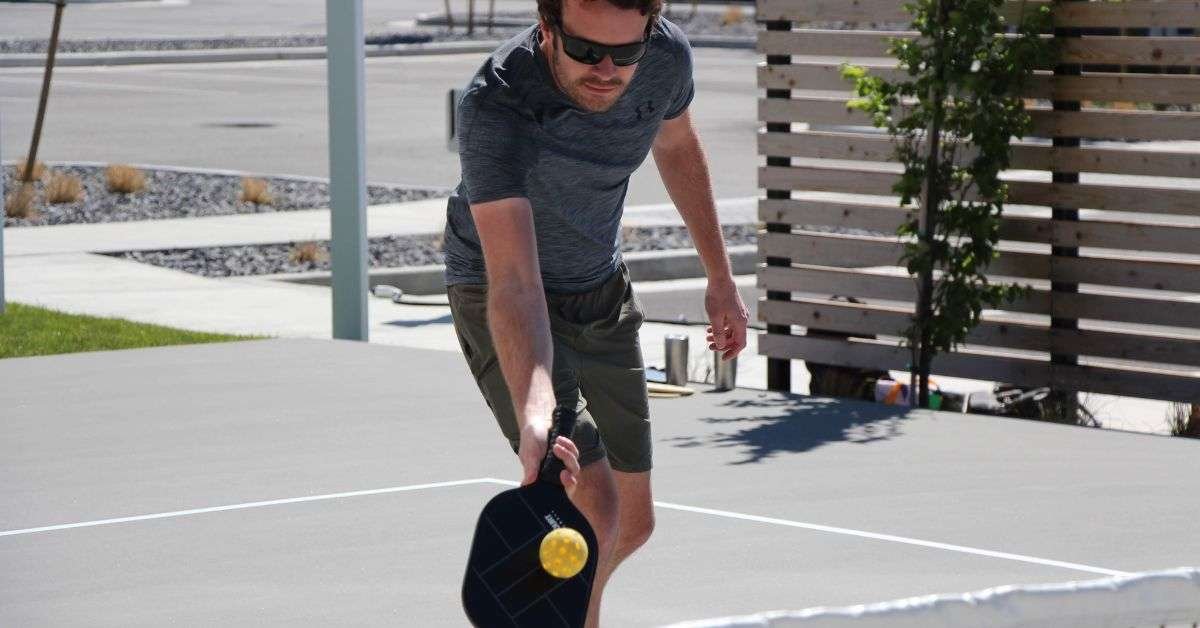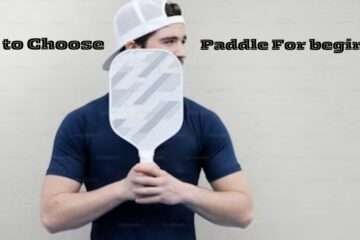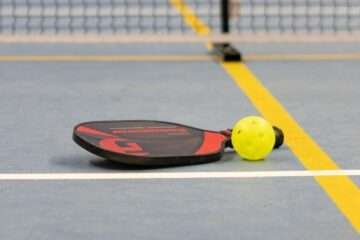Pickleball is the newest sports craze in the history of American sports, millions of people nationwide have gravitated toward pickleball as their preferred outlet for exercise and family fun. Many enthusiastic players have chosen to build pickleball courts right at home, saving them time and adding convenience.
Compared to tennis (7200 SF +/-), building a pickleball court takes up a much smaller space in the yard (1800 SF +/-). It can also be designed with a multi-sport mindset to enjoy other fun activities when not playing pickleball. This comprehensive guide will help you select the best elements to incorporate into your custom pickleball court.
Pickleball Court Dimensions
If you have the yard requirements at your Greater Cincinnati home, or you would like to play competitively/professionally, an official-sized court would be the best option. Official dimensions for professional-grade courts are laid out by our friends at USA Pickleball, the governing body of pickleball in the United States.
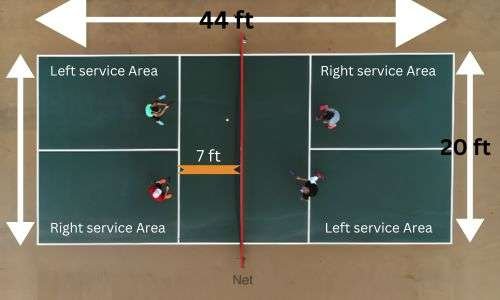
The line dimensions for an official pickleball court are 44 feet long by 20 feet wide. Including the out-of-bounds area (which is 10 feet on each end plus 7 feet on the sides) the total footprint for a court with official specifications is 34′ x 64′.
The net divides the playable area in half, with a “kitchen” or “non-volley zone” of 7 feet on each side, indicated by a line 7 feet from the net and parallel to it. The remaining playable area is divided in half by a line that is perpendicular to the net, creating left and right service areas on each side that are 15 feet long by 10 feet wide. Lines on each end and each side of the playable area mark the border between the playable area and the out-of-bounds zone.
Building a Pickleball Court in a Smaller Yard
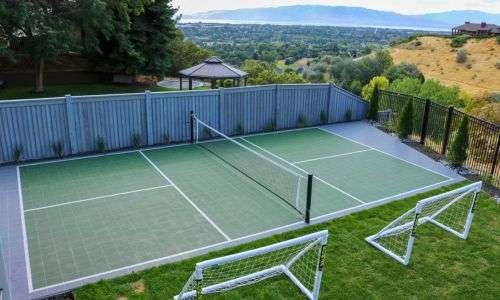
If your yard is limited in space or if your budget dictates a smaller court size, there is a solution. The dimensions of the out-of-bounds area can be reduced while still keeping the court lines regulation. Some common modified pickleball court dimensions built by GCA are 27’x49′, 30’x56′, and 32’x61′ If your court needs to be smaller than the regulation 20’x44′ line measurements, all the dimensions can be scaled to a percentage of the original. Whenever possible, the court should be oriented north to south to avoid the sun’s glare.
Sub-Base Construction
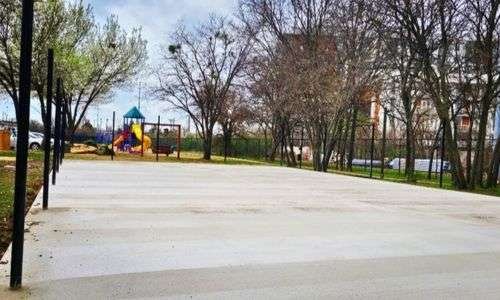
Before you select the appropriate surface for your pickleball court, a suitable base must be constructed. Concrete and asphalt are the most common choices, though asphalt will likely require more maintenance throughout the life of the court. A concrete base will last longer and generally have less surface undulations than asphalt.
Playing Surface Options
Once the base is installed, a professional playing surface should be applied (although having lines striped directly on the concrete/asphalt base is a viable thrifty option for recreational play). There are two options that are primarily considered for the best playability and performance: 1)Sport Court “SportGame Pickleball (PB)” and 2) Acrylic Coatings.
SportGame PB has excellent comfort/shock absorption, superb drainage, and is a very long-lasting option (15-year warranty). Acrylic coatings are a traditional option and are found in many park/school settings.
Cost of Building a Pickleball Court
If you want a properly prepped area with a compacted gravel base, proper concrete with reinforcement in it, fenced, textured surface painted, in-ground post pockets, etc, you could expect to pay at least $50k-$60k for a single court. It could be higher depending on where you are located and current concrete prices (have a look). if the area is already flat, it can help to reduce costs.
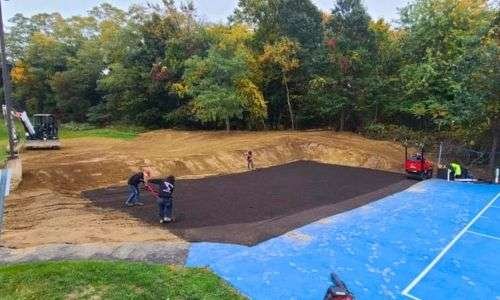
The cost of constructing a pickleball court depends on far too many variables and geographical differences to be asked in a national (or global) forum. It all depends on regional markups, the quality of materials utilized, your individual property requirements, where you are how much preparation work is needed in the region where you want the court. Get quotes from qualified, local court-building professionals.
You may like to read, How to Start Playing Pickleball
What makes Pickleball Courts the Best you have seen?
Determining the “best” pickleball court can be subjective, as it depends on individual preferences, needs, and priorities. However, high-quality pickleball courts often share certain features that contribute to their overall excellence. The basic rule is never to spend the resources to build a pickleball court that limits play or creates safety hazards at any level. Here are some factors that can make a pickleball court stand out:
Intimate Play Spaces
Every professional court has netting that runs from the ground to about chest level around each individual court. Since courts are netted off, it creates easy walkways to every court. There is a barrier separating each court from the others. So every court feels like you’re playing on the center court because there’s no one that can walk onto your court. Only a missed hit from another court can impede play, which doesn’t happen too often.
No court is ever built with too much room. My list of priorities includes – it should have plenty of space between the courts—10 feet or more; with fences separating the courts along the sides as well as the back. Multiple access points minimize traffic that causes games to have to pause for players to enter and leave other courts. The facility should include a paddle rack and well-documented rules with regard to court layout.
Are some courts designated by skill level? Are there challenging courts? Is there a designated court for drilling with a power outlet for the rental ball machine? Do winners stay and split or always play 4 on, 4 off?
Maintenance Considerations
Depending on where you are located, good drainage and a way to get rid of leaves on the courts is a big deal. Low-maintenance materials and design elements can contribute to the long-term durability of the court.
Individually Fenced with lighting that is Built Correctly
Too many courts are built with bad lighting. And bad lighting doesn’t necessarily mean not enough of it. It needs to be arranged so that the players don’t get blinded in the middle of the point. For outdoor courts or indoor facilities, good lighting arrangements are essential, especially if games are played in the evening or during low-light conditions.
Have 3 Colors for the Court
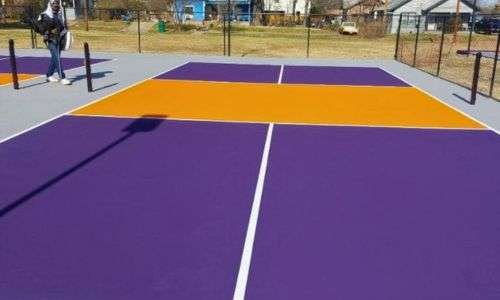
Choose good colors for the court and surrounding area – be sure they contrast with the balls people tend to use! Clear and contrasting lines make it easy for players to see the boundaries of the court.
Have a dark-colored kitchen, so the sun doesn’t bounce into your face. if you can afford it, use cushioning. It can double the cost, but if you play on a cushioned court, you will never want to play on one without cushioning.
Wind Block
Plant effective windbreaks approximately 40 feet outside the courts. Include walkways, benches, and seating between the trees and fences, with a gate for each court. This design provides shade, convenient access between courts without crossing others, minimizes wind interference, and reduces external noise. Ensure the baselines run north and south, avoiding an east/west orientation.
Courts May Need to be Covered
Depending on their location, courts may require covering. In Florida, playing under the hot sun isn’t ideal, and frequent rain limits playing time. Courts should have a North/ South orientation, with 10 feet minimum space to move beyond all side and end lines. Permanent nets, courts have 3 surface colors (with NVZ painted a different color for better visuals), high fencing on 3 sides, and covered 2-3 row seating/ bleacher area.
Where to Begin Building Pickleball Court
There are many additional variables to consider when building a court (elevations/excavation, drainage, zoning requirements, fencing, etc). A great way to get a budget together and check for overall feasibility is to schedule a site visit where a GCA court builder can help provide these details and lay out the space in your yard. Going to check out other courts to get a feel for size, options, etc. is another great step to make sure you are getting your preferred court options.
But if you are not getting courts built by people who really understand the construction side AND the functional side, then I think it’s a mistake. Awesomely built courts with size or layout-related issues are problematic. Perfectly designed, sized, and appointed courts that are poorly built are also problematic. Just my opinion… Visit Pickleball Lessons for more updates.

